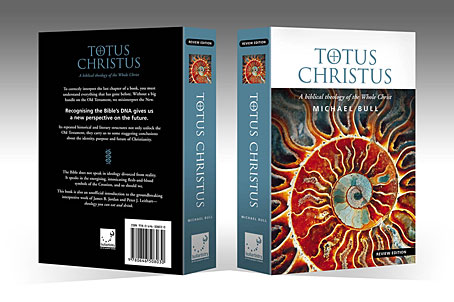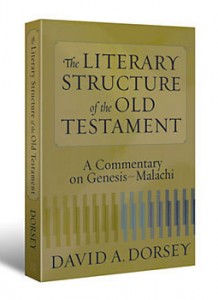Jul
18
2009
Genesis (Sabbath) – Grace and peace (Shalom in Christ)
[Ephesians 1]
…..Exodus (Passover) – Children of wrath made members of the
…..household of God by the blood of Christ [Ephesians 2:1-17]
……….Leviticus (Firstfruits) – Access to the Father as the dwelling
……….place of God. The mystery of God opened [Ephesians 2:18-3:12]
……………Numbers (Pentecost) – Filled with all the fullness of God,
……………strengthened with might through His Spirit [Ephesians 3:13-21]
……….Deuteronomy (Trumpets) – Law repeated. The troops presented
……….to God. Inheritance. Music [Ephesians 4:1-6:9]
…..Joshua (Atonement) – Every saint wears the armour
…..of the High Priest [Ephesians 6:10-18]
Judges (Tabernacles) – Paul the ambassador to the Gentiles
[Ephesians 6:19-24]
Comments Off | tags: Ephesians, Literary Structure, Paul, Systematic typology | posted in Biblical Theology
Jul
15
2009

Tim writes:
“[Totus Christus is] a book which certainly makes you think. While I have read other books on Biblical theology, looking at the structure of the Bible in that way (the Dominion pattern, feasts, etc.) is an idea which I’d never considered at all before. At first I didn’t quite get what each part of the pattern involves, even after you’d explained it, but after seeing it applied to a few sections of the Bible I was fine. I think its helped me get a better understanding of how God has revealed himself through the Bible. Continue reading
Comments Off | tags: Bible Matrix, Chiasm, Dominion Theology, Feasts, Literary Structure, Systematic typology | posted in Biblical Theology, Totus Christus
Jul
12
2009
“Nebuchadnezzar the king of Babylon has devoured me;
he has crushed me; he has made me an empty vessel;
he has swallowed me like a monster” (Jeremiah 51:34)
Continue reading
Comments Off | tags: Chiasm, Feasts, Jonah, Literary Structure | posted in Biblical Theology
Jul
8
2009
A passage from Why Johnny Can’t Preach: The Media Have Shaped the Messengers, by T. David Gordon:
 “All of their sermons are about Christian truth or theology in general, and the particular text they read ahead of time merely prompts their memory or calls their attention to one of Christianity’s important realities (insofar as they perceive it). Their reading does not stimulate them to rethink anything, and since the text doesn’t stimulate them particularly (but serves merely as a reminder of what they already know), their sermon is not particularly stimulating to their hearers.
“All of their sermons are about Christian truth or theology in general, and the particular text they read ahead of time merely prompts their memory or calls their attention to one of Christianity’s important realities (insofar as they perceive it). Their reading does not stimulate them to rethink anything, and since the text doesn’t stimulate them particularly (but serves merely as a reminder of what they already know), their sermon is not particularly stimulating to their hearers.
Continue reading
Comments Off | tags: C. S. Lewis, Literary Structure, Preaching, T. David Gordon | posted in Quotes
Jul
4
2009

Some encouraging comments on the review edition of my book, just to balance things up a bit! Kelby in the U.S. blogged:
Very recently I was privileged enough to receive an electronic copy of a book penned by Australian graphic designer and theologian Mike Bull. It has been quite a harrowing experience. I’m not even a quarter of the way through the 800-page tome, and I’m already overwhelmed by all the things Bull expects me to internalize. This definitely isn’t armchair theology, folks.
The book in question is titled Totus Christus: A Biblical Theology of the Whole Christ. One of its foundational assertions is that there is a fundamental pattern laid out through the entire Bible–a pattern which his book is modeled on. This pattern is woven throughout all of Scripture, and can help us to understand Biblical structure and idioms…
Continue reading
Comments Off | tags: Literary Structure, Totus Christus | posted in Totus Christus
Jun
27
2009
or Silencing the Higher Critics

Yet more on literary analysis of the Bible as a ‘terrible marvel‘; a review of two books. As Warren Gage has commented, we are on the verge of a tremendously creative time in Biblical theology. But this to me seems also to be an element of scholarship returning home, older and wiser, from a wilderness of unbelief.
Genesis: The Story We Haven’t Heard
by Paul Borgman. Downers Grove, IL: Intervarsity Press, 2001. 252 pages.
The Literary Structure of the Old Testament: A Commentary on Genesis-Malachi
by David A. Dorsey. Grand Rapids, MI: Baker Books, 1999. 330 pages.
Reviewed by Timothy Paul Erdel, Ph.D., Archivist and Assistant Professor of Religion and Philosophy, Bethel College, Mishawaka, IN.
“I have been fascinated by the primal power of Old Testament stories for as long as I can remember. From my perspective, there is no clearer window on human character, no greater storehouse of hard and holy truths. Yet some tales are deeply disturbing. Phyllis Trible calls them ‘texts of terror.’ Even the most familiar passages may seem strangely distant. So I relish each time a preacher or teacher sheds new light on these ancient Hebrew narratives.
Continue reading
Comments Off | tags: Abraham, Babel, C. S. Lewis, Chiasm, Compromise, David A. Dorsey, Higher Criticism, Isaiah, Jeremiah, Literary Structure, Warren Gage | posted in Biblical Theology, Quotes
May
3
2009
I just noticed that the passage concerning the slain Lamb (Rev. 5) and the passage concerning the victory of the church (in 9-11) correspond chiastically.
The first is the Adam conquering Herod’s Egypt and moving out through a bloody door (Passover/Circumcision)
SCROLL: Word – Most Holy Place – Garden
……LAMB: Sacrament – Holy Place – Land
…………NATIONS: Government – Courts – World
These cover the three territories corrupted by Adam, Cain and the ‘sons of God’. Between this ‘first generation’ (head) and the ‘next generation’ (body), there is a battle in the first century ‘wilderness’.
………………WILDERNESS BATTLE: Gospel as Pentecost Law
Later, there is the redeemed Eve conquering Herod’s Jericho and crossing the river into a heavenly country over the corpse (Atonement/Baptism)
…………SUNRISE ARMY of 200 million Jew/Gentile saints:
…………Government – Courts - World
……CHRIST the true brother/High Priest with the little scroll:
……Sacrament – Holy Place - Land (and Sea)
TWO WITNESSES, saints as the Ark cherubim: Word – Most Holy Place - Garden
Not only does this pattern follow the seven feasts of Leviticus 23 (if we include the central wilderness), each of these seven points contains the same sevenfold structure within itself. It is like Zechariah’s Lampstand with 49 lights. And this is just another overlay on the already manifold structures in Revelation. There really is no bottom to this book.
Comments Off | tags: Atonement, Baptism, Cain, Chiasm, Circumcision, Herod, Literary Structure, Passover, Revelation, Zechariah | posted in Biblical Theology, The Last Days
Apr
21
2009
A friend of mine discovered John Piper and devoured just about every online sermon in under 12 months. It changed him profoundly. (I highly recommend Piper’s biographical series. I should listen to them again.)
Anyhow, my friend shared that Piper had made a comment about not ‘getting’ the prophets. As there are so many views on what the prophets are talking about, this is understandable. Based on what I’ve heard from James Jordan and my resulting studies, I would like to offer some helpful hints. They seem to play out, from what I can see.
Continue reading
Comments Off | tags: Bible history, Exile, James Jordan, John Piper, Literary Structure, Tabernacle, The Prophets | posted in Biblical Theology, The Last Days, The Restoration Era
Apr
16
2009
Rieu’s theory of Jesus as a ‘man of letters’ is borne out by the structure of the Sermon on the Mount. As with many of the prophets, His “book” begins with a preamble that follows the themes of Israel’s 7 feasts in Leviticus 23.
Jesus begins with the Sabbath rest of those who have a humble spirit, works through those who mourn for their sins at Passover, and ends with the Atonementcovering of the blood of those who would be persecuted yet to be shed on the Land. And at Tabernacles, their reward is in heaven.
Continue reading
Comments Off | tags: Feasts, Leviticus, Literary Structure | posted in Biblical Theology
Apr
15
2009
 “I began writing this book some ten years ago, although my interest in Hebrew literary structure goes back a decade before that. My fascination with the subject was kindled when I began teaching Old Testament courses in seminary. At that time I was struck by the apparent lack of order within many of the biblical books. Jeremiah seemed hopelessly confused in its organisation; so did Isaiah and Hosea and most of the prophets. Song of Songs and Ecclesiastes appeared to be in almost complete disarray, and even the more orderly historical books, such as Joshua and Kings, showed signs of strangely careless organisation. Why did the biblical authors write like this? I would never write a book, an article, or even a private letter with such carelessness of arrangement.
“I began writing this book some ten years ago, although my interest in Hebrew literary structure goes back a decade before that. My fascination with the subject was kindled when I began teaching Old Testament courses in seminary. At that time I was struck by the apparent lack of order within many of the biblical books. Jeremiah seemed hopelessly confused in its organisation; so did Isaiah and Hosea and most of the prophets. Song of Songs and Ecclesiastes appeared to be in almost complete disarray, and even the more orderly historical books, such as Joshua and Kings, showed signs of strangely careless organisation. Why did the biblical authors write like this? I would never write a book, an article, or even a private letter with such carelessness of arrangement.
I was intrigued by the possibility that the Hebrew authors might have organised their compositions according to literary conventions that were different from ours. I began to discover, over a period of years, that several structuring patterns rarely used by us were remarkably common in the books of the Hebrew Bible, particularly chiasmus (symmetry), parallelism, and sevenfold patterns. I was increasingly struck by how often these patterns had been utilised to arrange biblical books…
It was my mother who gave me a love for literature. She read to my brother Stephen and me regularly, from as early as I can remember. I still have many fond memories of those wondrous bedtime stories, whose structures — like the Bible — were designed for the ear, not the eye.”
David A. Dorsey, The Literary Structure of the Old Testament, p.9-10 (Preface).
Comments Off | tags: Chiasm, David A. Dorsey, Ecclesiastes, Hebrew, Isaiah, Jeremiah, Literary Structure, Old Testament, Song of Songs | posted in Quotes






























